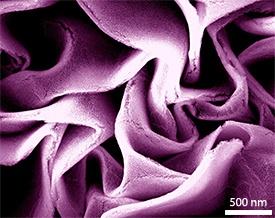

08/29/2011

© 2011 ACS
Wrinkly films of nanoporous gold just 100 nanometers thick make an excellent surface for ultra-high sensitivity chemical diagnostics, a team of WPI-AIMR researchers led by Mingwei Chen has shown1. The nanoporous surface allows even a single molecule of an analyte to be detected using a technique known as surface-enhanced Raman spectroscopy (SERS).
Raman spectroscopy takes advantage of the fact that many molecules interact with light and scatter it in a characteristic way. Because different molecules scatter light at different wavelengths, the technique can be used to identify an unknown chemical. For many molecules, however, the scattering effect is very weak, which means that the scattered light is extremely difficult to detect.
The nanoporous gold surface prepared by Chen and his colleagues amplifies the Raman effect to an extent that SERS can be used to detect the presence of single molecules. Other SERS substrates with this capability have been prepared in the past, but they tend to have drawbacks such as low stability or poor reproducibility. “In our research, we developed a controllable method to fabricate large-scale, stable and reproducible SERS substrates,” says Ling Zhang, a postdoctoral fellow of the research team.
To fabricate their wrinkled gold substrate, the researchers attached flat gold sheets with nano-sized pores onto a pre-strained polymer substrate. Heating caused the polymer to shrink, which in turn caused the overlying nanoporous layer of gold to wrinkle up (see image). Different wrinkle structures were obtained by varying the size of the nanopores, with the best results obtained using 26-nanometer holes.
Key to the Raman-enhancing effect of the gold surface is the way that its three-dimensional wrinkled texture interacts with light. The nanogaps formed on the wrinkled surface allow light to induce collective oscillations of electrons at particular points or ‘hotspots’ on the surface by an effect known as surface plasmon resonance. The plasmonic effect is known to amplify the Raman scattering signals of nearby molecules on the surface, but this is the first time that such a plasmonic-based surface has been produced reliably.
The local SERS enhancement factor at ‘hotspots’ on the wrinkled gold surface can be larger than 100 million, the researchers showed. “This is comparable to the best Raman-active nanomaterials and enables single-molecule detection,” says Chen.
The team is continuing work to improve the performance of their gold surface for practical analytical chemistry applications. “We are now optimizing the chemical composition and structure of the wrinkled films to further increase the density and local enhancement factors of the ‘hot spots’,” says Chen.
Zhang, L., Lang, X., Hirata, A., & Chen, M. Wrinkled nanoporous gold films with ultrahigh surface-enhanced raman scattering enhancement. ACS Nano 5, 4407–4413 (2011). | article
This research highlight has been approved by the authors of the original article and all information and data contained within has been provided by said authors.